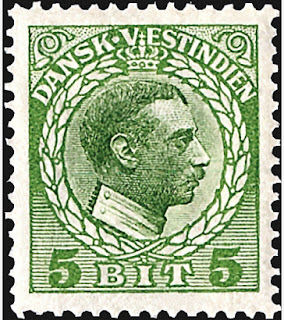This is not an exception for American overseas terrtories. With the exception of the Philippines, which did issue its own postage stamps during the United States administration of 1899-1946 (likely because the Philippines had its own currency at the time of annexation, the Philippine Peso, and that currency was retained by the US Administration), and the overprints issued in the immediate aftermath of the Spanish-American war of 1898 for Guam and Puerto Rico, American overseas terrritories have used the postage stamps of the United States from the time they came under American rule.
One of the most beautiful stamps issued during the US Administration of the Philippines, the 1932 2c Mount Mayon pictorial (image courtesy mountainstamp.com)
USA 1c Benjamin Franklin stamp of 1894 overprinted -GUAM- for use on that island after its capture by US forces during the Spanish-American War of 1898. Regular USA issues would be used on the island after 1901. (image courtesy pecollectibles.com)
1899 stamp issued by the US administration in Hawaii, the high value in a set of three stamps that would be the last separate issue for Hawaii before its stamps were replaced by regular US stamps. (image courtesy treasurecoastamps.com)
Danish West Indies stamp depicting King Christian X, one of a set of eight issued in 1915 that would be the last stamps released before the transfer to American sovereignty in 1917 and the end of the Western Virgin Islands separate philatelic identity (image courtesy linns.com)
I always thought it was a pity that the overseas external territories *cough colonies* of the United States lost their philatelic identity so quickly after they came under American administration. As the Mount Mayon stamp from the Philippines shows, the potential for some truly beautiful stamps that depicted these, to Americans in the contiguous 48 states, exotic lands governed by the United States would have been great.
The Postal Service would, to a degree, do this with the Overseas Territories issues of 1937, although Guam and American Samoa were not given any recognition in this series.
The 1937 External Territories issue of the US Postal Service, honoring Hawaii, Alaska, Puerto Rico and the US Virgin Islands, but NOT Guam or American Samoa. (image courtesy delcampe.net)
But...it never came to pass. Alaska and Hawaii acceded to Statehood in 1959. While Puerto Rico became a Commonwealth/Estado Libre Asociado in 1952, it did not regain postal autonomy, and given recent events on the island, the likelihood it will become a full-fledged state in the next decade seem quite high. And the US Virgin Islands, American Samoa and Guam remain external territories, with varying degrees of self-government, and (non-voting) representation in the US House of Representatives. And they continue to use regular United States postage stamps.
On a similar note, I think it is also sad that the five French overseas departments (départements d'outre-mer) also have lost philatelic autonomy. No more separate issues for Guadeloupe, Martinique, French Guiana, Reunion or, more recently, Mayotte. The distinctive cultures of these five territories produced some gorgeous stamps during their philatelic lifetimes, and while the French have issued stamps depicting scenes or personalities from these regions from time to time over the past sixty years, something I think was definitely lost to philately with the end of their philatelic independence.
Iconic low value stamp from the 1947 pictorial issue of Guadeloupe. Alas this would be the final set of stamps issued specifically for the island, as stamps of France itself would replace Guadeloupe stamps shortly thereafter. (from author's collection)
Stamp issued by France in 1970 depicting the Rocher du Diamant in the overseas department of Martinique. Martinique, like Guadeloupe, issued its last stamps in 1947. A beautiful stamp to be sure, but only one of a handful of stamps released in the past nearly seventy years depicting the overseas departments (image courtesy delcampe.net).
Aruba 1993 Folklore issue, from the days when Aruba's philatelic production was conservative, relevant to the island, and the stamp designs in general of a very high quality. (image courtesy delcampe.net)
Aruba 2014 Classic Cars issue, released by the philatelic agency the Aruba Post Office sold its soul to. Higher-than necessary face values, little cultural resonance to the island, and less that stellar artwork.(image courtesy delcampe.net)









Very nice topic. I hadn't given it much thought before, but there were not a lot of unique U.S. territory stamps, unlike the "colonies" of other nations.;-)
ReplyDeleteYes, a missed opportunity I think, but since the United States in the late-19th C prided itself on not really being an "imperial" power with colonies (in spite of the Spanish-American War) it kinda makes sense that separate "colonial" issues would not be done. The Phlippines was the exception, and that was more to do with its much larger population (over 7 Million at time of annexation) and separate currency already in existence. So keeping the Philippine postal service separate made sense from an administrative point of view, especially since the entire idea behind the US "experiment" in the Philippines was to prepare it for independence sooner rather than later, unlike most colonial powers who saw the colonies as remaining permanent parts of the imperial realm until almost the very end of the colonial era.
ReplyDelete